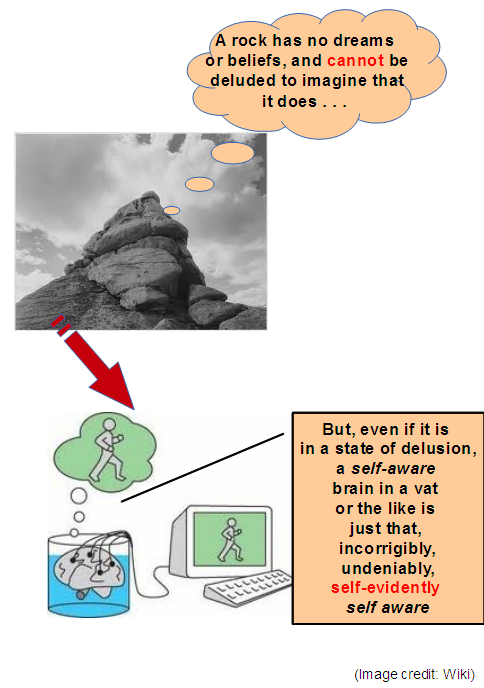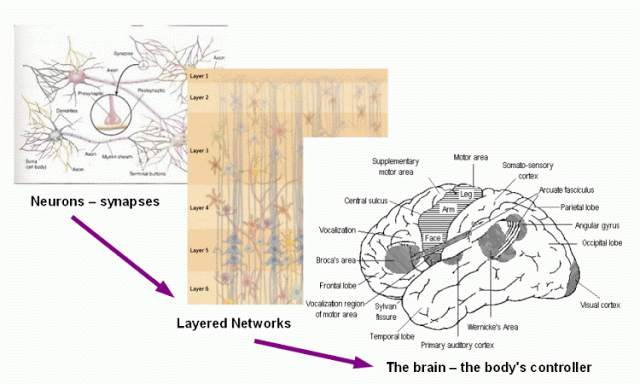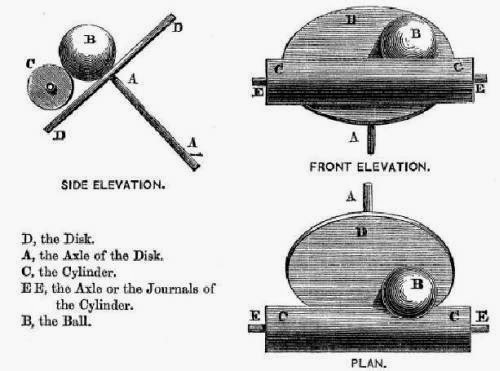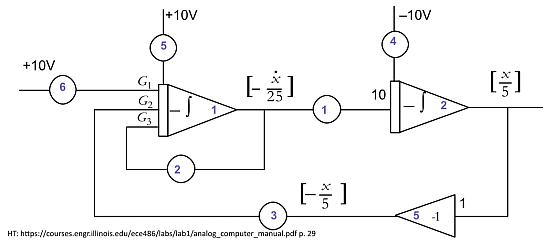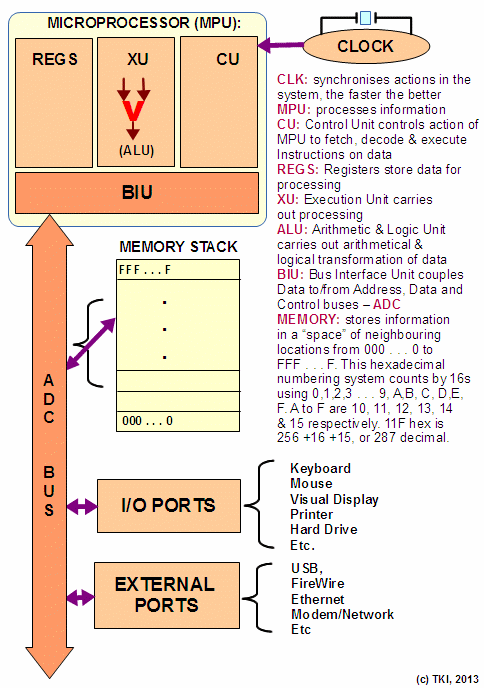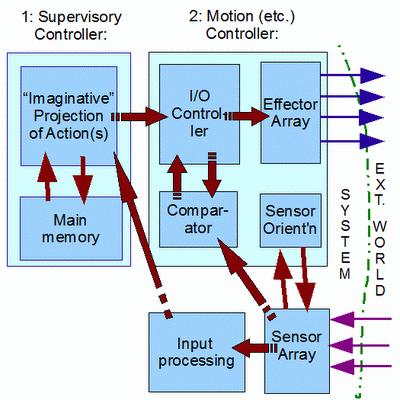It seems that self-aware mindedness is now on the table for discussion.
In that context, I see that Reciprocating Bill is arguing:
Given the fact that you entertain the notion that brains aren’t necessary for dreaming, why can’t that which dreams without a brain be a rock?
This is a carry over from a discussion where I have pointed out:
And also how a neural network is an example of how refined rock organised into a GIGO-limited computational unit still has not broken through from mechanical cause effect computation — which a raw rock obviously cannot do — to self-aware insightful reasoning contemplation:
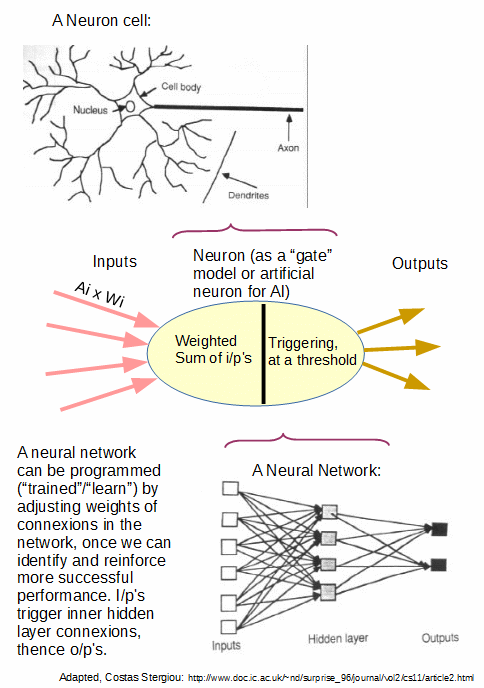
. . . in the brain:
That is, just as for a Thomson Mechanical Integrator:
. . . or [U/d, Dec 11 ’14, HT UoIL] the op amp based electronic equivalent:
. . . or a more conventional digital computer microprocessor central processing unit:
. . . a neural network based computational processor is blindly computing in accord with cause-effect chains imposed by its organisation, more or less as Leibniz long ago pointed out by using his famous analogy of the Mill in Monadology 17:
[P]erception, and that which depends upon it, are inexplicable by mechanical causes, that is to say, by figures and motions. Supposing that there were a machine whose structure produced thought, sensation, and perception, we could conceive of it as increased in size with the same proportions until one was able to enter into its interior, as he would into a mill. Now, on going into it he would find only pieces working upon one another, but never would he find anything to explain perception.
Accordingly, I responded to R-B on the problem of trying to get North by going West:
___________________
>> It is quite evidently a fact that raw, in-nature rocks are passive in the face of forces of chance and mechanical necessity.
That raw rocks have no dreams SHOULD be obvious as a matter of basic fact . . . save to those with a talking point agenda. Failure to acknowledge evident fact as a start point for all else, is not a healthy sign.
Second, I looked at processed, refined rocks that are made into devices that process information. Lo, behold, just as Leibniz pointed out, they too are passive, blindly interacting in cause-effect chains. That is, the functional organisation that effects computation has not changed the basic pattern, that is why GIGO rules in Thomson mechanical integrators, digital computers and neural networks alike.
Maybe, you are old enough to recall how the first Pentiums, after being triumphantly announced, had to undergo a major recall because an error was discovered in the floating point math coprocessor embedded in the devices. That is illustrative on how blind cause-effect chains fail to attain to actual reasoning in which inference is a process of insight based meaningful inference. As Reppert summarised (cited at 29 above):
. . . let us suppose that brain state A, which is token identical to the thought that all men are mortal, and brain state B, which is token identical to the thought that Socrates is a man, together cause the belief that Socrates is mortal. It isn’t enough for rational inference that these events be those beliefs, it is also necessary that the causal transaction be in virtue of the content of those thoughts . . . [But] if naturalism is true, then the propositional content is irrelevant to the causal transaction that produces the conclusion, and [so] we do not have a case of rational inference. In rational inference, as [C S] Lewis puts it, one thought causes another thought not by being, but by being seen to be, the ground for it. But causal transactions in the brain occur in virtue of the brain’s being in a particular type of state that is relevant to physical causal transactions.
This means that, even with computational functional organisation, we have not been able to make rocks dream . . . nor can we.
Computational processing in various architectures — INCLUDING neural networks, artificial or natural (= brains) — is patently qualitatively, categorically distinct from the self aware, insightful, rational and creative contemplation we experience and observe in one another.
Where also, the notion that such dreams may emerge beyond a magical threshold is tantamount to trying to draw out something from nothing — from non-being. Until you identify and demonstrate a sufficient causal pattern or an observed fact, we can set this notion to one side as science fiction fantasy.
There is a fundamental distinction between blind, signal processing based computation and insightful, self aware rational reasoning.
So, the fact that self-aware mindedness exists is pointing to something that an a priori materialism influenced age has great difficulty acknowledging. Namely, that it is at least possible that the material world we experience as self aware conscious persons may not be the only world we experience.
In a world dominated by evolutionary materialism dressed up in a lab coat, that may be very hard to recognise or allow in the door.
But, surely, at minimum we should keep an open mind on the subject, given that we can see that computation and contemplation are fundamentally distinct phenomena.
By now, it should be plain that blind, mechanical, programmed cause effect chain computation is simply not a process of rational insight. Which carries with it the point that we should be willing to recognise that neural network or digital computer or mechanical integrator based signal processing is not even on the right path to be self-aware, conscious reasoning and meaningful contemplation.
So, rocks not only have no dreams in the raw states as a matter of observed fact, but we can show why refined and organised rocks that form computational entities, by virtuet of the radical difference between cause-effect links and ground-consequent inferences, are not even on the right road to dreaming.
Which is not just the musings of one of those suspect “IDiots” and “Creationists in cheap tuxedos” — yes, we are very aware of the prejudices and contempt-laced accusatory attitudes that are ever so common — out on a silly blog that objectors to design theory come to to try to see if they can convince the unwashed heathen to give up their backward ways.
Nope, it is a direct implication of the so-called hard problem of consciousness, as stated by Chalmers, e.g. in his original paper as just linked:
The really hard problem of consciousness is the problem of experience. When we think and perceive, there is a whir of information-processing, but there is also a subjective aspect. As Nagel (1974) has put it, there is something it is like to be a conscious organism. This subjective aspect is experience. When we see, for example, we experience visual sensations: the felt quality of redness, the experience of dark and light, the quality of depth in a visual field. Other experiences go along with perception in different modalities: the sound of a clarinet, the smell of mothballs. Then there are bodily sensations, from pains to orgasms; mental images that are conjured up internally; the felt quality of emotion, and the experience of a stream of conscious thought. What unites all of these states is that there is something it is like to be in them. All of them are states of experience.
It is undeniable that some organisms are subjects of experience. But the question of how it is that these systems are subjects of experience is perplexing. Why is it that when our cognitive systems engage in visual and auditory information-processing, we have visual or auditory experience: the quality of deep blue, the sensation of middle C? How can we explain why there is something it is like to entertain a mental image, or to experience an emotion? It is widely agreed that experience arises from a physical basis, but we have no good explanation of why and how it so arises. Why should physical processing give rise to a rich inner life at all? It seems objectively unreasonable that it should, and yet it does.
Notice, Chalmers’ confession: “It seems objectively unreasonable . . . ” and his contrasting creedal confession that follows, that somehow it has to be that the conscious emerges from the inherently non-conscious; per, the a priori materialism thesis that prevails as a dominant school of thought in our time, and which do often demands our genuflection.
But, sometimes, when you have come to what you regard as a puzzling paradox to be resolved by pushing forward ever more diligently, what you have actually arrived at is a reduction to absurdity that your paradigm makes it all but impossible to acknowledge.
You are not ever going to go North by going due West, in effect. (On a round planet such as ours, you can go West to get East . . . as Columbus proposed, but you will not ever get North by going West; as, the two directions are orthogonal.)
Let us call this, for onward reference, The get North by going West fallacy.
A manifestation of sheer wrong-headedness. Which, if insisted upon in the teeth of correction, becomes absurdity.
No wonder, Searle’s Chinese Room thought exercise then has so much bite, as it exposes the orthogonal difference between blind mechanical processing and genuine self-aware, language using understanding . . . a pivotal component of general — as opposed to limited — intelligence and rational mindedness:
Imagine that a person—me, for example—knows no Chinese and is locked in a room with boxes full of Chinese symbols and an instruction book written in English for manipulating the symbols. Unknown to me, the boxes are called “the database” and the instruction book is called “the program.” I am called “the computer.”
People outside the room pass in bunches of Chinese symbols that, unknown to me, are questions. I look up in the instruction book what I am supposed to do and I give back answers in Chinese symbols.
Suppose I get so good at shuffling the symbols and passing out the answers that my answers are indistinguishable from a native Chinese speaker’s. I give every indication of understanding the language despite the fact that I actually don’t understand a word of Chinese.
And if I do not, neither does any digital computer, because no computer, qua computer, has anything I do not have. It has stocks of symbols, rules for manipulating symbols, a system that allows it to rapidly transition from zeros to ones, and the ability to process inputs and outputs. That is it. There is nothing else. [Cf. Jay Richards here.]
The problem for evolutionary materialism is even deeper than that, as J B S Haldane long ago highlighted, in a profoundly linked observation:
“It seems to me immensely unlikely that mind is a mere by-product of matter. For if my mental processes are determined wholly by the motions of atoms in my brain I have no reason to suppose that my beliefs are true. They may be sound chemically, but that does not make them sound logically. And hence I have no reason for supposing my brain to be composed of atoms. In order to escape from this necessity of sawing away the branch on which I am sitting, so to speak, I am compelled to believe that mind is not wholly conditioned by matter.” [“When I am dead,” in Possible Worlds: And Other Essays [1927], Chatto and Windus: London, 1932, reprint, p.209.]
Reppert caps off:
It isn’t enough for rational inference that these events be those beliefs, it is also necessary that the causal transaction be in virtue of the content of those thoughts . . . [But] if naturalism is true, then the propositional content is irrelevant to the causal transaction that produces the conclusion, and [so] we do not have a case of rational inference. In rational inference, as [C S] Lewis puts it, one thought causes another thought not by being, but by being seen to be, the ground for it.
In short, you patently cannot get north by going west.
Just so, to demand why couldn’t a rock — raw or refined — be a basis for contemplation, is to try to go North by going West instead.
It is also to profoundly misunderstand the point that has been made, which has taken in not only raw rocks that are simply passive in the face of forces, but also rocks that have been processed to form signal processing computational entities.
As Searle has decisively shown, you inherently are not going in the right direction when you try to reduce insight to blind algorithmic or similar signal processing.
As Haldane has shown, blind processing — even in a neural network — is not even linked to self-aware rational insight.
And as Reppert has highlighted from Lewis [with Leibniz lurking in the background], until you acknowledge that the ground-consequent relationship is not equal to or transmutable into the cause-effect one you can get nowhere.
It is high time to see that one cannot ever get North by insisting on Going West, no mind how determined one is. >>
___________________
So, it seems that until we become willing to acknowledge that one cannot get North by going West, there can be no mutually agreed progress on this subject.
But, of course, Planck long ago pointed out that too often old paradigms die hard, one funeral at a time as the old generation passes off the scene stuck in its old ways. In an age of pervasive computation, sooner or later, it is going to get through to a critical mass that wait a minute, rocks have no dreams and computation is not equal to contemplation — so let’s stop trying to get North by going West.
And, it is the job of a blog such as this, to stand up early and point that out — even when it is decidedly unfashionable to do so in the face of the strong riptide of the age. END
PS: As it keeps cropping up, here is the Smith Model in summary outline:
PPS: U/D Jun 29 — as it seems that the issue of inference that mind may not necessarily be based on computational material substrates is coming up in the comments, and as in a follow-on thread on FSCO/I and its significance, here, I add the following from that post, on the inference from evident fine tuning of the observed cosmos we inhabit, to design of the cosmos:
>> . . . there is in fact only one actually observed cause of FSCO/I beyond that 500 – 1,000 bit threshold, design. Design by an intelligence. Which dovetails neatly with the implications of the needle in haystack blind search challenge. And, it meets the requisites of the vera causa test for causally explaining what we do not observe directly in light of causes uniquely known to be capable of causing the like effect.
So, perhaps, we need to listen again to the distinguished, Nobel-equivalent prize holding astrophysicist and lifelong agnostic — so much for “Creationists in cheap tuxedos” — Sir Fred Hoyle:
From 1953 onward, Willy Fowler and I have always been intrigued by the remarkable relation of the 7.65 MeV energy level in the nucleus of 12 C to the 7.12 MeV level in 16 O. If you wanted to produce carbon and oxygen in roughly equal quantities by stellar nucleosynthesis, these are the two levels you would have to fix, and your fixing would have to be just where these levels are actually found to be. Another put-up job? . . . I am inclined to think so. A common sense interpretation of the facts suggests that a super intellect has “monkeyed” with the physics as well as the chemistry and biology, and there are no blind forces worth speaking about in nature. [F. Hoyle, Annual Review of Astronomy and Astrophysics, 20 (1982): 16.]
And again, in his famous Caltech talk:
The big problem in biology, as I see it, is to understand the origin of the information carried by the explicit structures of biomolecules. The issue isn’t so much the rather crude fact that a protein consists of a chain of amino acids linked together in a certain way, but that the explicit ordering of the amino acids endows the chain with remarkable properties, which other orderings wouldn’t give. The case of the enzymes is well known . . . If amino acids were linked at random, there would be a vast number of arrange-ments that would be useless in serving the pur-poses of a living cell. When you consider that a typical enzyme has a chain of perhaps 200 links and that there are 20 possibilities for each link,it’s easy to see that the number of useless arrangements is enormous, more than the number of atoms in all the galaxies visible in the largest telescopes. [–> ~ 10^80] This is for one enzyme, and there are upwards of 2000 of them, mainly serving very different purposes. So how did the situation get to where we find it to be? This is, as I see it, the biological problem – the information problem . . . .
I was constantly plagued by the thought that the number of ways in which even a single enzyme could be wrongly constructed was greater than the number of all the atoms in the universe. So try as I would, I couldn’t convince myself that even the whole universe would be sufficient to find life by random processes – by what are called the blind forces of nature . . . . By far the simplest way to arrive at the correct sequences of amino acids in the enzymes would be by thought, not by random processes . . . .
Now imagine yourself as a superintellect [–> this shows a clear and widely understood concept of intelligence] working through possibilities in polymer chemistry. Would you not be astonished that polymers based on the carbon atom turned out in your calculations to have the remarkable properties of the enzymes and other biomolecules? Would you not be bowled over in surprise to find that a living cell was a feasible construct? Would you not say to yourself, in whatever language supercalculating intellects use: Some supercalculating intellect must have designed the properties of the carbon atom, otherwise the chance of my finding such an atom through the blind forces of nature would be utterly minuscule. Of course you would, and if you were a sensible superintellect you would conclude that the carbon atom is a fix.
Noting also:
I do not believe that any physicist who examined the evidence could fail to draw the inference that the laws of nuclear physics have been deliberately designed with regard to the consequences they produce within stars. [“The Universe: Past and Present Reflections.” Engineering and Science, November, 1981. pp. 8–12]
No wonder, in that same period, the same distinguished scientist went on record on January 12th, 1982, in the Omni Lecture at the Royal Institution, London, entitled “Evolution from Space”:
The difference between an intelligent ordering, whether of words, fruit boxes, amino acids, or the Rubik cube, and merely random shufflings can be fantastically large, even as large as a number that would fill the whole volume of Shakespeare’s plays with its zeros. So if one proceeds directly and straightforwardly in this matter, without being deflected by a fear of incurring the wrath of scientific opinion, one arrives at the conclusion that biomaterials with their amazing measure or order must be the outcome of intelligent design. No other possibility I have been able to think of in pondering this issue over quite a long time seems to me to have anything like as high a possibility of being true. [This appeared in a book of the same title, pp. 27-28. Emphases added.]>>
